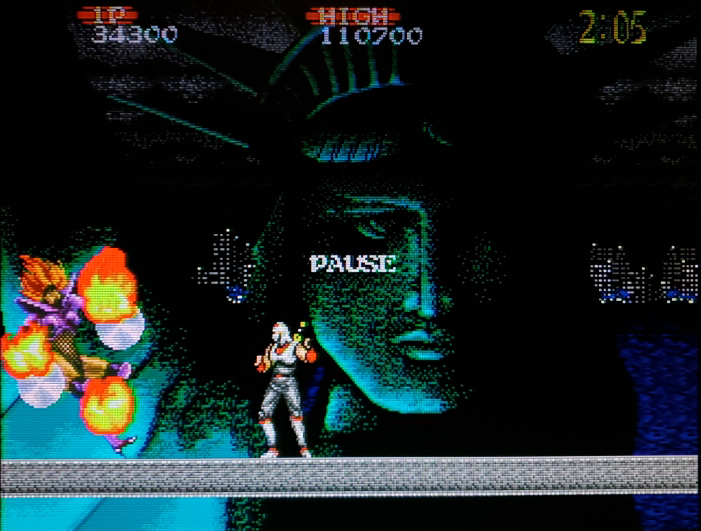






It’s Thanksgiving! Time to stuff the turkey, mash the potatoes, and sharpen the shurikens because I’m continuing my arbitrary tradition of November ninja gaming. Well, not completely arbitrary. I am thankful for ninja. You are, too, if you know what’s good for you.
This time, I’m checking back in with Sega’s Shinobi series. Specifically, 1990’s Shadow Dancer: The Secret of Shinobi, the second of three unique installments created for the Genesis. Shadow Dancer’s release was sandwiched between those of two much better remembered masterpieces, The Revenge of Shinobi and Shinobi III: Return of the Ninja Master, seemingly dooming it to perpetual footnote status.
It’s easy to see why, frankly. Revenge and Shinobi III both strove to transcend the basic gameplay of the 1987 arcade original, adding a health bar in place of one-hit deaths, expanding your ninja hero’s arsenal of moves, and upping the complexity of the level design. By contrast, Shadow Dancer serves as a humble continuation of the old school Shinobi tradition. This means those one-hit deaths are back. Ditto the comparatively limited moveset and bite-sized stages. The result is a far less ambitious title that can be completed in roughly half the time as either of its Genesis “big brothers.” About twenty minutes or so, once you get the hang of it.
Before I go on, I should clarify that Shadow Dancer: The Secret of Shinobi is in no way synonymous with the 1989 arcade Shinobi sequel called simply Shadow Dancer. Confusing, I know. Suffice it to say that the Genesis game is no port. It shares no art, sound, level layouts, enemies, or even plot points with its namesake. The only elements common to both are a ninja and a dog.
A dog? That’s right. Shadow Dancer’s sole twist on the established Shinobi formula is giving your ninja (who’s either recurring protagonist Joe Musashi or his son Hayate, depending on which region’s manual you’re reading) a canine companion to wreak havoc with. This good boy’s name is Yamato and he comes in handy throughout your quest to save New York City from the evil cult Union Lizard. Union…Lizard? Sounds more like a progressive rock outfit to me. Whatever.
The fight against Union Lizard plays out across five rounds, with each consisting of two compact action-platforming stages followed by a boss battle. The exception is the last round, which features only a single longer-than-average level leading up to its boss. Generally speaking, your goals in a given area are to rescue any hostages present and then reach the exit before time runs out. Between rounds, you’re free to indulge in a brief mini-game of shooting other helpless ninja in the back as you freefall down a skyscraper. Take out enough and you’ll win some extra lives. Continues are limited, so it’s always worth giving these bonus rounds your best shot.
Joe/Hayate’s core moves are largely the same as they were in the 1987 Shinobi. He can walk, crouch, and jump, of course. Jumping can also be used to transition between higher and lower platforms if you hold the appropriate direction. The single context-sensitive attack button will trigger a sword swipe or kick if an enemy is within range and a shuriken toss if not. Ninja magic returns as well, allowing you to fall back on a screen clearing elemental barrage once per stage.
A final button directs Yamato. Hold it down to ready him and then release it when you want him to charge forward and latch onto into the first enemy he comes in contact with. If successful, the foe will be temporarily immobilized. That’s your cue to swoop in and take them out before they can shake free. You need to time these assaults carefully, however, since Yamato can take damage. If he does, he won’t be killed. Rather, he’ll shrink down to puppy size and be useless for a time. It’s weird, alright, but I get why the development team didn’t want digital doggie death on their consciences.
I found myself enjoying Shadow Dancer more than I expected to. I can’t deny that it earns its obscurity. It’s almost criminally short for a 1990 home console exclusive and a major step backward in terms of scope from the envelope pushing Revenge of Shinobi. The graphics and music are similarly a downgrade, albeit still above average for the time and hardware. All that said, the first entry in the saga remains a timeless classic in my eyes and this is essentially more of it with an appealing animal sidekick thrown in for good measure. Definitely give it a look if that sounds promising to you. My main criticism is actually that Yamato should have played an even bigger role the action. He disappears completely whenever a boss shows up, turning what could have been the ultimate showcases of your cross-species teamwork skills into standard solo affairs. Such a missed opportunity! If you’re gonna have a gimmick, I say lean into that sucker.
Welp, that’s another Ninjavember on the books. Until next time, Dear Reader, may all your turkey be moist and all your kills stealthy.

Shadow Dancer is cool. I could see someone being disappointed coming off of Revenge of Shinobi, but I actually like it a bit better than it. I also think it’s superior to the arcade game, which I finally got around to trying recently. I guess I didn’t realize just how different they are from each other!
LikeLiked by 1 person
Yeah, I almost want to say they should have called this one Shadow Dancer 2.
LikeLike